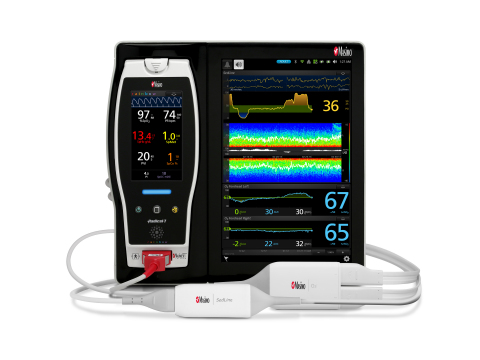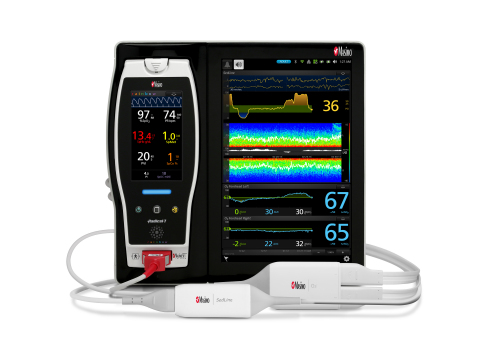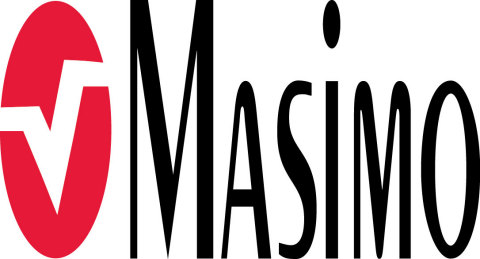COPENHAGEN, Denmark--(BUSINESS WIRE)--Masimo (NASDAQ: MASI) announced today the findings of an abstract presented at Euroanaesthesia 2018 in which researchers compared Masimo Patient State Index (PSi), a processed EEG parameter provided by SedLine® brain function monitoring (in this study, first generation SedLine), to Medtronic Bispectral Index (BIS™) in monitoring the depth of anesthesia of two groups of patients: healthy volunteers undergoing hepatotomy for liver donation and cirrhotic patients undergoing liver resection. The researchers found “excellent” agreement between the two methods as well as similar sevoflurane consumption, and found that PSi 1.0 was less affected by electrocautery.1
In the study, Dr. Yassen and colleagues at Menoufia University in Shibin El Kom, Egypt, sought to test agreement between two brain function monitoring indices, Masimo PSi and Medtronic BIS. They monitored 60 patients in 4 sub-groups: with healthy livers undergoing hepatotomy (15 PSi, 15 BIS) and with cirrhotic livers undergoing resection (15 PSi, 15 BIS). Sensors for both technologies were simultaneously applied and anesthetists monitoring PSi were blinded to BIS results and vice versa. To measure the level of interference from electrocautery on each index, the researchers noted whether BIS and PSi values were present (displayed) or absent each time the electrocautery unit was activated.
The researchers found “An excellent degree of reliability between PSi and BIS at all measuring points.” With 804 data pairs total, they calculated an overall intra-class correlation of 0.92 (95% confidence interval of 0.91-0.93, p<0.001). Using Bland-Altman analysis, they calculated overall mean bias difference of 2.19 (95% confidence interval of 1.40-2.98, p<0.0001). PSi-guided and BIS-guided sevoflurane consumption were similar: 65.67ml+/-31.60ml and 68.47ml+/-27.63ml respectively, p=0.983.
The researchers found the following rates of incidence of electrocautery interference:
|
|
||||||
|
Diathermy interference? |
PSi 1.0 | BIS | Test of significance | |||
| No | 96.67% | 31.67% |
Z=7.4246 (p ≤0.001) |
|||
| Yes | 3.33% | 68.33% | ||||
The researchers concluded, “Agreement between PSI and BIS during surgery is excellent among patients with healthy or cirrhotic livers. Both can be used to monitor trends of anaesthesia depth changes and equally consumed similar sevoflurane volumes. However PSI allowed for continuous monitoring without interruptions from electrocautery.”
SedLine brain function monitoring helps clinicians monitor the state of the brain under anesthesia with bilateral acquisition and processing of four leads of electroencephalogram (EEG) signals. Next Generation SedLine, now available worldwide, features an enhanced PSi with less susceptibility to EMG interference and improved performance in low power EEG cases, as well as an enhanced Multitaper Density Spectral Array (DSA).
@MasimoInnovates | #Masimo
Reference
- Yassen K, Elsheikh M, Helal S, Badawy E, and Metwally A. Patient State Index versus Bispectral Index in cirrhotic patients and non-cirrhotics undergoing hepatic resection: A controlled randomized study. Proceedings from Euroanaesthesia 2018, Copenhagen, Denmark. #1167.
About Masimo
Masimo (NASDAQ: MASI) is a global leader in innovative noninvasive monitoring technologies. Our mission is to improve patient outcomes and reduce the cost of care. In 1995, the company debuted Masimo SET® Measure-through Motion and Low Perfusion™ pulse oximetry, which has been shown in multiple studies to significantly reduce false alarms and accurately monitor for true alarms. Masimo SET® has also been shown to help clinicians reduce severe retinopathy of prematurity in neonates,1 improve CCHD screening in newborns,2 and, when used for continuous monitoring with Masimo Patient SafetyNet™* in post-surgical wards, reduce rapid response activations and costs.3,4,5 Masimo SET® is estimated to be used on more than 100 million patients in leading hospitals and other healthcare settings around the world,6 and is the primary pulse oximetry at 17 of the top 20 hospitals listed in the 2017-18 U.S. News and World Report Best Hospitals Honor Roll.7 In 2005, Masimo introduced rainbow® Pulse CO-Oximetry technology, allowing noninvasive and continuous monitoring of blood constituents that previously could only be measured invasively, including total hemoglobin (SpHb®), oxygen content (SpOC™), carboxyhemoglobin (SpCO®), methemoglobin (SpMet®), Pleth Variability Index (PVi®), and more recently, Oxygen Reserve Index (ORi™), in addition to SpO2, pulse rate, and perfusion index (Pi). In 2014, Masimo introduced Root®, an intuitive patient monitoring and connectivity platform with the Masimo Open Connect® (MOC-9®) interface, enabling other companies to augment Root with new features and measurement capabilities. Masimo is also taking an active leadership role in mHealth with products such as the Radius-7® wearable patient monitor, iSpO2® pulse oximeter for smartphones, and the MightySat™ fingertip pulse oximeter. Additional information about Masimo and its products may be found at www.masimo.com. Published clinical studies on Masimo products can be found at http://www.masimo.com/evidence/featured-studies/feature/.
ORi has not received FDA 510(k) clearance and is not available for sale in the United States.
*The use of the trademark Patient SafetyNet is under license from University HealthSystem Consortium.
References
- Castillo A et al. Prevention of Retinopathy of Prematurity in Preterm Infants through Changes in Clinical Practice and SpO2 Technology. Acta Paediatr. 2011 Feb;100(2):188-92.
- de-Wahl Granelli A et al. Impact of pulse oximetry screening on the detection of duct dependent congenital heart disease: a Swedish prospective screening study in 39,821 newborns. BMJ. 2009;Jan 8;338.
- Taenzer AH et al. Impact of Pulse Oximetry Surveillance on Rescue Events and Intensive Care Unit Transfers: A Before-And-After Concurrence Study. Anesthesiology. 2010; 112(2):282-287.
- Taenzer AH et al. Postoperative Monitoring – The Dartmouth Experience. Anesthesia Patient Safety Foundation Newsletter. Spring-Summer 2012.
- McGrath SP et al. Surveillance Monitoring Management for General Care Units: Strategy, Design, and Implementation. The Joint Commission Journal on Quality and Patient Safety. 2016 Jul;42(7):293-302.
- Estimate: Masimo data on file.
- http://health.usnews.com/health-care/best-hospitals/articles/best-hospitals-honor-roll-and-overview.
Forward-Looking Statements
This press release includes forward-looking statements as defined in Section 27A of the Securities Act of 1933 and Section 21E of the Securities Exchange Act of 1934, in connection with the Private Securities Litigation Reform Act of 1995. These forward-looking statements include, among others, statements regarding the potential effectiveness of Masimo SedLine® and PSi. These forward-looking statements are based on current expectations about future events affecting us and are subject to risks and uncertainties, all of which are difficult to predict and many of which are beyond our control and could cause our actual results to differ materially and adversely from those expressed in our forward-looking statements as a result of various risk factors, including, but not limited to: risks related to our assumptions regarding the repeatability of clinical results; risks related to our belief that Masimo's unique noninvasive measurement technologies, including Masimo SedLine and PSi, contribute to positive clinical outcomes and patient safety; risks related to our belief that Masimo noninvasive medical breakthroughs provide cost-effective solutions and unique advantages; as well as other factors discussed in the "Risk Factors" section of our most recent reports filed with the Securities and Exchange Commission ("SEC"), which may be obtained for free at the SEC's website at www.sec.gov. Although we believe that the expectations reflected in our forward-looking statements are reasonable, we do not know whether our expectations will prove correct. All forward-looking statements included in this press release are expressly qualified in their entirety by the foregoing cautionary statements. You are cautioned not to place undue reliance on these forward-looking statements, which speak only as of today's date. We do not undertake any obligation to update, amend or clarify these statements or the "Risk Factors" contained in our most recent reports filed with the SEC, whether as a result of new information, future events or otherwise, except as may be required under the applicable securities laws.




